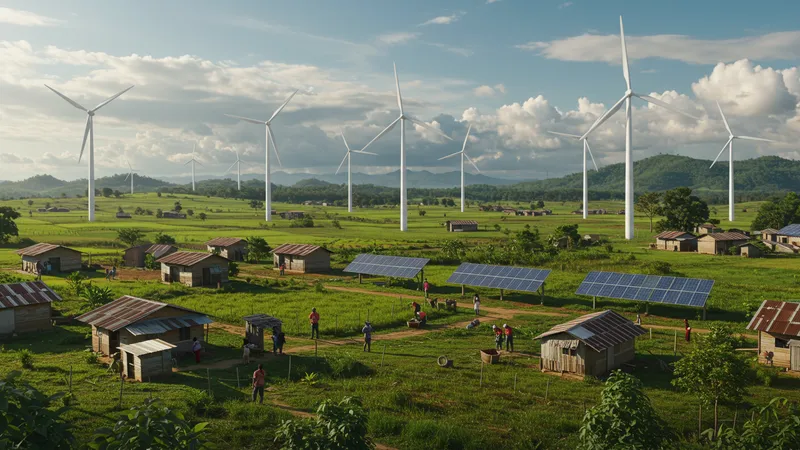

Imagine if a single investment could power not just your portfolio, but the entire planet. Shocked? You should be. Private equity in the energy transition is reshaping the very foundation of global finance.
This movement isn’t just about green energy; it’s a financial powerhouse gaining momentum faster than ever. From solar investments to hydrogen breakthroughs, get ready to dive deep into this timely upheaval.

Private equity firms are steering billions towards sustainable energy solutions. With climate change at the forefront, investors are seeing returns beyond what anyone thought possible. But what’s truly fascinating is the strategic pivot these firms are making. Forget traditional fossil fuels; solar, wind, and hydrogen are the new goldmines. It's a revelation shaking up boardrooms worldwide. But that's not even the wildest part…
Data shows that the energy transition could unlock unprecedented economic opportunities, even as the world battles environmental crises. We’re not just talking about profit; it’s about transformative growth that could redefine how we live and work. Industry leaders are compelled to adapt, but skeptics argue it’s too much, too fast. Here’s the kicker—some experts believe this is just the beginning of a financial revolution. What happens next shocked even the experts…
In the world of private equity, making the right bet on energy transition can lead to astronomical gains. Imagine investing in a solar company when it was still a fledgling startup, only to see it grow into a billion-dollar titan. That’s the kind of success story circulating among insiders. And here’s a twist—these aren't isolated incidents. Across the globe, savvy investors are staking claims on future energy giants, with groundbreaking results.

Take the case of wind energy. Once dismissed as unreliable, it now attracts private equity like a magnet. Investors are seeing impressive returns as technology improves and production costs plummet. It’s become a favored asset, with firms funneling resources to secure leadership positions. But there’s a hidden layer to this enthusiasm—government incentives. Tantalizing tax breaks and subsidies are making wind an irresistible proposition for those in the know. Yet, there’s more beneath the surface…
Hydrogen technologies represent another burgeoning trend. Quietly gathering momentum, these initiatives are poised to refine the transportation industry. Private equity firms are placing strategic bets, predicting hydrogen’s rise in prominence. High-stakes investments are leading to a boom in research and development, igniting a race towards more efficient energy solutions. However, there’s a surprising snag—public skepticism remains a barrier. Convincing the masses is a tougher sell, yet insiders remain optimistic. The narrative doesn’t end there…
The convergence of technology and energy is leading to innovative breakthroughs. From AI-enhanced grids to blockchain-driven transparency, the possibilities are endless. Private equity is at the center of this evolution, driving change with unprecedented vigor. Firms that embrace this digital transformation may well rewrite the rules of economic engagement. But what you read next might change how you see this forever.
While the energy transition is teeming with promise, it’s not without its perils. Private equity investors must navigate a thicket of potential pitfalls, from regulatory changes to technological obsolescence. These are risks that have already tripped up some of the smartest minds in finance. Remember, the stakes are sky-high, and a single wrong move can lead to monumental losses. But savvy investors remain undeterred. They're always on the lookout for early indicators of trouble.

One pressing issue is the regulatory landscape, which is far from being set in stone. Government policies can shift unexpectedly, turning viable projects into regulatory nightmares. Investors have found themselves scrambling to adapt, sometimes at great cost. Yet, those who maintain a proactive stance—anticipating changes rather than reacting—often come out ahead. This is where insider knowledge and connections are invaluable. Yet there's an underlying complexity to this dynamic…
Technological advancement can be a double-edged sword. While innovation drives the industry forward, it can also render existing investments obsolete at an alarming pace. Private equity firms must weigh the potential of emerging technologies against their inherent volatility. It's a balancing act riddled with uncertainty, but the potential rewards are too great to ignore. The race to back the next big breakthrough is on, and only the most astute investors will succeed. Yet there's a personal element to this high-stakes game…
Amidst these challenges, what makes all the difference is human foresight and adaptability. What separates winners from losers in this financial arena is the ability to pivot quickly and decisively. Investors who cultivate a mindset of continuous learning and evolution find themselves better equipped to seize opportunities. Their success stories are not just about money—they’re about resilience and vision. But there's an unexpected twist that could change everything.
As the energy transition gathers steam, the spotlight is turning to technologies that appear poised to redefine the landscape. Take carbon capture, for example—a breakthrough that promises to mitigate climate impact while driving financial returns. Private equity is paying close attention, pouring resources into startups pioneering this technology. These investments could prove transformative, promising to yield both incredible profits and ecological benefits.

Then there's the growing interest in smart grids, which are revolutionizing how energy is distributed. By utilizing AI to optimize flow and consumption, these grids could significantly reduce waste and enhance efficiency. Private equity firms see immense potential here, investing heavily in tech-savvy ventures that promise to disrupt the status quo. Yet, as promising as they are, these technologies come with their own set of challenges that few outsiders fully grasp…
Even so, the advent of battery storage technology may steal the show. Improved storage capacity has the potential to solve one of renewable energy's biggest issues: intermittency. As new developments emerge, private equity is ready to capitalize on this shift. However, navigating this landscape requires more than just capital; it demands insight into future trends and innovations. Investors are keen to spot tell-tale signs of success—as well as potential pitfalls. But timing is everything…
Ultimately, the fate of these game-changing technologies rests on swift and strategic implementation. As new discoveries unfold, those who hesitate risk being left behind. Investors with the courage to lead will shape the future of energy for decades to come. But there is a subtle twist that could redefine everything you think about this market.
The ripple effects of energy transition investments are being felt worldwide, reshaping economies and communities. Consider the transformative projects in developing nations, where renewable energy is providing power to areas that were previously off the grid. This shift has not only spurred economic growth but also significantly improved quality of life. Private equity firms are keen to contribute, as it aligns with both ethical values and profitable outcomes.

In addition to economic resurgence, these investments have profound environmental implications. By reducing dependency on fossil fuels, they're mitigating climate change and promoting sustainability. The resulting reduction in carbon footprint offers a beacon of hope in a world grappling with ecological decay. Yet, this beneficial cycle faces threats from unexpected quarters—competing industries that resist change.
Moreover, social dynamics are evolving due to energy transition ventures. These projects are creating jobs and fostering skills in sectors that are likely to dominate the future. Critics argue about job losses in traditional industries, yet experts believe the net impact will be positive overall. This optimistic outlook is driving investors to pour more capital into startups with transformational potential. But there’s a surprising social element shaping this trend…
Investments are not just reshaping landscapes—they're altering perceptions and collaboration between industries and countries. Global partnerships are being forged, connecting investors, governments, and local communities in a shared vision for a sustainable future. Navigating this intricate web of relationships is complex, yet the rewards are undeniable. But the groundwork being laid today may lead to an unexpected climax.
While the financial incentives in energy transition are attractive, many private equity investors are driven by more than just profit. Impact investing—a strategy aimed at generating both monetary returns and positive social or environmental effects—is gaining traction. This dual-purpose approach resonates with an increasing number of stakeholders eager to make a meaningful difference.

Governments worldwide are fuelling this interest with lucrative tax breaks and grants, encouraging private capital to flow into environmentally-friendly projects. These incentives are powerful motivators for firms looking for a strategic advantage. Still, the benefits aren't all as straightforward as they appear; there are potential hidden costs that come with such investments.
The global focus on sustainability has led to the emergence of green bonds and similar financial instruments. These tools allow investors to direct funds towards projects that align with environmentally-conscious goals. Private equity firms are finding these options to be a compelling addition to their portfolios, drawn by both the promise of returns and the allure of positive impact. However, the fine print reveals complexities that can catch investors off-guard if not carefully scrutinized.
With impact investing at the forefront, the lines between financial and ethical pursuits are blurring. As investors navigate this evolving landscape, they are discovering opportunities that transcend traditional financial metrics. This convergence is a hallmark of modern investing and suggests a future where impact and profit are not mutually exclusive. Yet there’s an underlying narrative that is poised to redefine this emerging sector…
Environmental, Social, and Governance (ESG) criteria have become a critical focus in private equity energy investments. These criteria are not just buzzwords; they're reshaping entire economies and investment strategies. Firms are increasingly using ESG factors to evaluate potential deals, ensuring capital is directed towards responsible growth.

ESG considerations are influencing investment decisions from boardrooms to fund managers, reflecting a broader societal shift towards accountability and transparency. The result is a heightened emphasis on sustainable practices and ethical governance, much to the approval of stakeholders. There’s a deepening dialogue around the integration of these values across portfolios, setting new standards in investment philosophy.
The rise of ESG has sparked innovation in measuring impact, leading to the development of advanced metrics and reporting tools. These innovations are allowing investors to better assess risks and identify opportunities aligned with sustainable values. However, this emphasis on ESG has its challenges, including a lack of uniform standards which can lead to inconsistency and confusion.
Nonetheless, the commitment to ESG principles is likely to catalyze significant advancements in the energy sector. As more firms adopt these guidelines, the impact on profitability and sustainability could be genuinely transformative. Yet, hidden beneath this progress narrative is an unresolved tension that few have anticipated…
Strategic alliances are becoming a key feature of energy transition investments, with firms joining forces in unprecedented ways. These partnerships allow private equity players to pool resources, share risks, and enhance their competitive edge. The resulting collaborations are creating synergies that would be difficult to achieve independently.

These alliances extend beyond the confines of the private sector. Governments and public entities are increasingly entering into partnerships with private investors to accelerate energy projects. Such collaborations are unlocking new opportunities for funding and innovation, blending public oversight with private ingenuity. Nevertheless, these relationships can be complex and require careful navigation to achieve mutual benefit.
Cross-border partnerships are also gaining momentum, fueled by globalization and technological advances. Investors are capitalizing on diverse markets and expertise, facilitating projects that promise global reach and impact. However, these partnerships come with challenges, including regulatory hurdles and cultural differences that must be adequately addressed to succeed.
Strategic alliances are laying the groundwork for future breakthroughs in energy transition. As firms and governments work together, the potential for groundbreaking achievements in sustainability is vast. But there’s a looming conflict of interest within these alliances that could shift the balance of power in unexpected ways.
Innovation hubs are rapidly emerging as pivotal catalysts in energy transition investments. These centers of creativity and technological development are attracting private equity interest by fostering cutting-edge research and entrepreneurship. The solutions being incubated within these hubs are often at the forefront of sustainable energy technology.

Private equity firms are recognizing the potential of these hubs to drive their portfolios forward. Investments in these centers of innovation offer access to the latest technological advancements and state-of-the-art solutions. While the promise is strong, navigating these environments can be complex due to the fast-paced evolution and inherent risk of startups.
Success in innovation hubs requires a delicate balance of support and guidance. Investors must be prepared to offer more than just capital—they need to provide mentorship and strategic direction to maximize the potential of emerging ventures. This hands-on approach is crucial to nurturing breakthroughs that could redefine energy markets.
The dynamic nature of innovation hubs presents both opportunities and challenges for investors. While the promise of the next big invention is enticing, it demands patience and a willingness to embrace ambiguity. Yet, these very traits are what could ultimately lead to revolutionary advancements. But unexpected challenges lie hidden within these lively ecosystems.
The financial dynamics of the energy transition are reshaping traditional economic theories. Private equity investments in this sector are driving an unparalleled shift in cost structures and market behavior. From reduced operational costs to profound return on investment, the economic implications are monumental.

Investors are witnessing a convergence of opportunity and necessity. As natural resource depletion looms, sustainable energy sources are increasingly seen as both viable and essential. The cost advantages of transitioning are becoming clear, with renewables offering competitive, often superior returns. However, understanding the nuances of these economics requires deep expertise and insight into market trends.
Scarcity of resources isn't the only factor influencing this economic narrative. The ongoing development of more efficient technologies further accentuates the financial viability of these investments. As innovation continues, the calculus of investment will likely favor those agile enough to adapt quickly to new realities.
The momentum of this economic shift is undeniable. Investors embracing these changes stand to benefit from both the financial and environmental resilience of a new energy landscape. Yet, the broader implication of this economic pivot is still unfolding, hinting at complex scenarios that may redefine energy transition strategies.
Policy plays a crucial role in shaping the trajectory of energy transition investments. Government frameworks and regulations often act as both a catalyst and a barrier to new initiatives. Private equity firms must maneuver through this landscape with precision, understanding the policy drivers that impact their investments.

The dynamic interaction between policy and investment creates both opportunities and risks. Incentives from policy reforms can lead to increased profitability, but restrictive regulations can hamper progress. Investors require astute awareness of these influences and must advocate for policies that promote sustainable energy growth.
Global climate commitments, such as the Paris Agreement, exert profound influence on energy policy. These international accords drive national strategies and inform policy changes that impact investment potential. However, translating commitments into actionable policy can be uneven across regions, posing a risk to investors without comprehensive strategic insight.
Policy is a double-edged sword—creating paths for growth while sometimes imposing barriers that limit potential. Successful navigation of this space requires acute awareness and strategic foresight. But policy is just one piece of a much larger puzzle that continues to evolve in unpredictable ways.
The global pandemic has altered the investment landscape, reshaping priorities and strategies in profound ways. Energy transition investments are no exception, as firms reevaluate their approaches in light of new realities. The crisis has accelerated the adoption of renewable technologies, revealing both vulnerabilities and opportunities.

Investors have sought resilience and sustainability—key themes emerging from the pandemic experience. Energy transition offers both, serving as a hedge against future disruptions. Private equity has responded by channeling capital into projects aligned with these objectives, aiming to harness newfound resilience.
But the pandemic has underscored the inherent uncertainties in global markets. Adapting investment strategies requires an understanding of rapidly changing consumer behaviors and emerging trends. The shift towards digitalization and decentralized energy is one such trend that investors are keenly observing.
The post-pandemic era presents a unique moment of opportunity for energy transition investments. By embracing flexibility and innovation, investors can position themselves for success in a world markedly altered by recent events. There’s an unexpected twist to this story, one further illuminated by recent experiences.
Private equity's involvement in energy transition is set to deepen, marking a significant evolution in the sector. As the world grapples with climate change and environmental sustainability, private equity offers a powerful vehicle for positive change. Firms are poised to play an increasingly central role in steering the energy landscape toward greener horizons.

The integration of emerging technologies into investment strategies indicates a forward-thinking approach among private equity players. From AI to blockchain, these tools promise to enhance efficiency and transparency, offering new dimensions to traditional investment practices. The potential is immense, yet achieving success requires agile adaptation to rapid technological advancements.
A crucial aspect of future private equity investment lies in collaboration and networking. Partnerships with stakeholders, ranging from startups to government entities, enable the pooling of expertise and resources. These collaborations are instrumental in overcoming barriers and fostering innovation, setting the stage for transformative investments.
The private equity sector stands at a crossroads, with the potential to shape the trajectory of energy transition. As firms embrace this responsibility, the impact on economies and ecosystems could be vast. However, the future holds unforeseen challenges that must be navigated with care and precision. The journey has only just begun.
The tides of energy transition in private equity are turning with unprecedented speed and scale. What once seemed distant is now a palpable reality, demanding immediate attention and action. As stakeholders unite with shared vision and purpose, the ensuing transformation will redefine industries, economies, and the very fabric of our society. Share and bookmark this article to stay informed about the unfolding evolution that could shape our future.